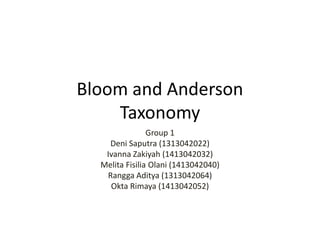
Bloom and anderson taxonomy
- 1. Bloom and Anderson Taxonomy Group 1 Deni Saputra (1313042022) Ivanna Zakiyah (1413042032) Melita Fisilia Olani (1413042040) Rangga Aditya (1313042064) Okta Rimaya (1413042052)
- 2. • The major differences lie in the more useful and comprehensive additions of how the taxonomy intersects and acts upon different types and levels of knowledge — factual, conceptual, procedural and metacognitive. This melding can be charted to see how one is teaching at both knowledge and cognitive process levels. Please remember the chart goes from simple to more complex and challenging types of thinking.
- 4. Taxonomy of the cognitive domain Bloom’s Taxonomy 1956 Anderson and Krathwohl’s Taxonomy 2001 1. Knowledge: Remembering or retrieving previously learned material. Examples of verbs that relate to this function are: know identify relate list define recall memorize repeat 1. Remembering: Recognizing or recalling knowledge from memory. Remembering is when memory is used to produce or retrieve definitions, facts, or lists, or to recite previously learned information. 2. Comprehension: The ability to grasp or construct meaning from material. Examples of verbs that relate to this function are: restate locate report recognize explain express illustrate interpret draw represent differentiate conclude 2. Understanding: Constructing meaning from different types of functions be they written or graphic messages or activities like interpreting, exemplifying, classifying, summarizing, inferring, comparing, or explaining.
- 5. 3. Application: The ability to use learned material, or to implement material in new and concrete situations. Examples of verbs that relate to this function are: apply relate develop translate use operate practice calculate show exhibit dramatize 3. Applying: Carrying out or using a procedure through executing, or implementing. Applying relates to or refers to situations where learned material is used through products like models, presentations, interviews or simulations. 4. Analysis: The ability to break down or distinguish the parts of material into its components so that its organizational structure may be better understood. Examples of verbs that relate to this function are: differentiate contrast investigate detect survey classify deduce 4. Analyzing: Breaking materials or concepts into parts, determining how the parts relate to one another or how they interrelate, or how the parts relate to an overall structure or purpose
- 6. 5. Synthesis: The ability to put parts together to form a coherent or unique new whole. Examples of verbs that relate to this function are: compose produce design assemble create prepare predict modify tell 5. Evaluating: Making judgments based on criteria and standards through checking and critiquing. Critiques, recommendations, and reports are some of the products that can be created to demonstrate the processes of evaluation. In the newer taxonomy, evaluating comes before creating as it is often a necessary part of the precursory behavior before one creates something. 6. Evaluation: The ability to judge, check, and even critique the value of material for a given purpose. Examples of verbs that relate to this function are: judge assess compare evaluate conclude measure deduce argue decide, choose rate, select estimate 6. Creating: Putting elements together to form a coherent or functional whole; reorganizing elements into a new pattern or structure through generating, planning, or producing. This process is the most difficult mental function in the new taxonomy.
- 8. Levels of Knowledge The first three of these levels were identified in the original work, but rarely discussed or introduced when initially discussing uses for the taxonomy. Metacognition was added in the revised version. • Factual Knowledge – The basic elements students must know to be acquainted with a discipline or solve problems. • Conceptual Knowledge – The interrelationships among the basic elements within a larger structure that enable them to function together. • Procedural Knowledge – How to do something, methods of inquiry, and criteria for using skills, algorithms, techniques, and methods. • Metacognitive Knowledge – Knowledge of cognition in general, as well as awareness and knowledge of one’s own cognition. (29)